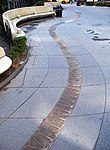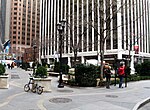56 Beaver Street

56 Beaver Street (also known as the Delmonico's Building and 2 South William Street) is a structure in the Financial District of Manhattan in New York City, United States. Designed by James Brown Lord, the building was completed in 1891 as a location of the Delmonico's restaurant chain. The current building, commissioned by Delmonico's chief executive Charles Crist Delmonico, replaced Delmonico's first building on the site, which had been built in 1837. The building is a New York City designated landmark and a contributing property to the Wall Street Historic District, a National Register of Historic Places district. The eight-story structure, clad in brick, brownstone, architectural terracotta, occupies a triangular lot at the western corner of the five-pointed intersection of William, South William, and Beaver Streets. The facade is articulated into three horizontal sections similar to the components of a column, namely a two-story base, a five-story shaft, and a one-story capital. The building contains a curved corner with a portico that provides access to the restaurant on the lower stories. Inside, there is a restaurant space in the basement and first story, while the upper floors contain 40 condominiums. The current building opened on July 7, 1891, with the restaurant at the base and top floor, as well as office space on the third through seventh floors. After 56 Beaver Street was sold to the American Merchant Marine Insurance Company in 1917, the restaurant was closed and the building became an office structure known as the Merchant Marine House. The building was then sold twice in the 1920s before the City Bank-Farmers Trust Company foreclosed on the building in 1933. Oscar Tucci purchased the lower level and first floor, then opened a restaurant. Tucci eventually acquired the entire building in 1953, occupying all floors; his family continued to run the restaurant until the 1980s. The building's upper stories were renovated in the early 1980s, and Ed Huber operated Delmonico's there from 1982 to 1993. Time Equities acquired the building in 1995; converting the upper stories into apartments; the lower stories operated yet again as a restaurant from 1998 to 2020.
Excerpt from the Wikipedia article 56 Beaver Street (License: CC BY-SA 3.0, Authors, Images).56 Beaver Street
Beaver Street, New York Manhattan
Geographical coordinates (GPS) Address Phone number Website Nearby Places Show on map
Geographical coordinates (GPS)
| Latitude | Longitude |
|---|---|
| N 40.705 ° | E -74.010277777778 ° |
Address
Delmonico's
Beaver Street 56
10004 New York, Manhattan
New York, United States
Open on Google Maps










